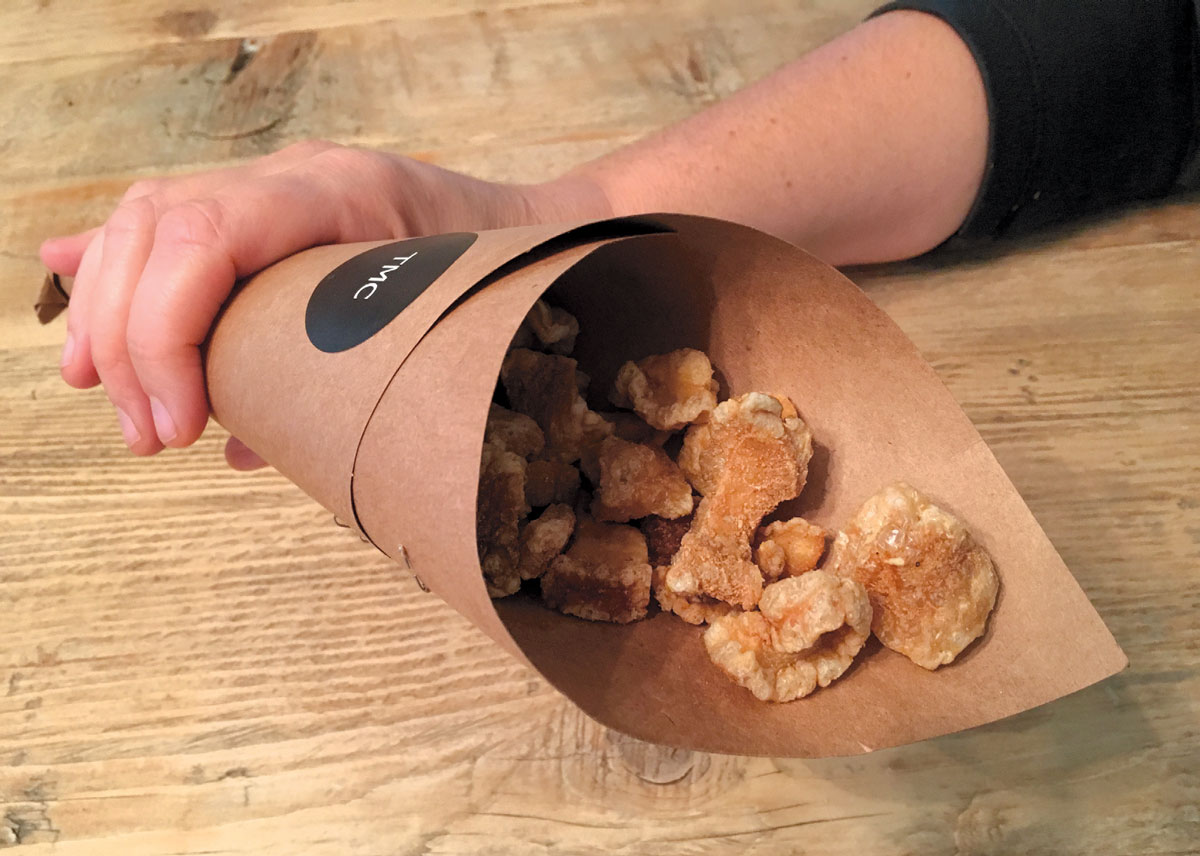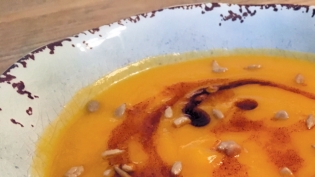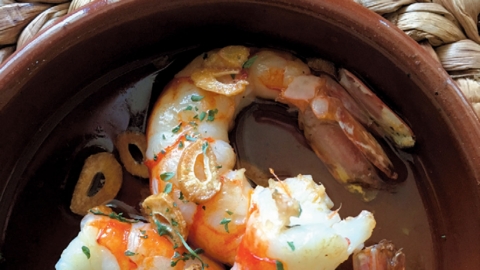The Mediterranean Table
Spain Heads South for the Winter
At first glance, the kitchen in Alba Sunyer-Olle’s Greenville home looks like any other busy South Carolina mom’s, down to the jar of fried pork rind snacks on the counter. Then you notice canisters labelled farina and sucre, a well-used espresso machine, and the can of pimenton dulce used in the last dish this Catalan-born chef created. Chef Alba (whose last name is a traditional combination of her mother’s and father’s surnames) followed husband Javi from Barcelona to Greenville in 2008, bringing three children and hopes of successfully introducing the Upstate to Spanish and Catalan cuisine. Her now-thriving business, The Mediterranean Corner, fulfills that dream, offering Spanish cooking classes, catering private parties and dinners, and hosting lively team-building events centered around making tapas.
The kitchen is a way of life for this enterprising chef. “I was born in a house where the grandma was there, my mom was there, someone was cooking all day for the family,” Alba says. She explains that the women would start planning meals upon awakening, going each morning to local producers and growers. From an early age, “It was a ritual every day to get the ingredients and start preparing things, like stews, in the morning.”
When pressed, Alba will admit to knowing culinary luminaries Ferran Adrià and José Andrés (both from Catalonia, the fiercely independent-minded northeast region of Spain). El Turia, the iconic Las Ramblas restaurant where Alba’s family won fans for five decades, was adjacent to Barcelona’s famed La Boqueria market. “It was farm-to-table every day,” says Alba. Alba and Adrià share a passion for what he calls “deconstructivist” cooking. Complementing the Spanish classics she creates, Alba wows event guests with molecular treats: tomato water spheres, which burst in the mouth, or Manchego foam atop tapas, a twist on Spain’s preferred cheese. But even though Adrià’s modern techniques inspire her, Chef Alba never strays far from her culinary roots.
After eight years in America, she still resists the urge to eat on the run. “For us, it was a shock when we got here,” she reveals. “I couldn’t understand why people are eating in their car, or families were eating at different times. In Spain, the family eats together. Stores close at 1:00; schools stop, kids walk home. Out comes the tablecloth, the first course, the second course, dessert. At 3pm, the kids go back to school, and the workday continues until 8:30 or 9:00.”
Albas also admits being surprised by America’s vitamin and supplement industry. “We eat a lot of fish and vegetables— my kids will eat a whole plate of green beans—so we don’t eat vitamins; we get that from the variety of food that we eat. The Mediterranean diet has all the ingredients and vitamins that you need. And the way we eat is really good: sitting down, no stress, feeling the flavor, talking with the family.” As if on cue, Alba’s college-age daughter pops into the kitchen for a chat, then a hug and kiss on departure, a relationship cultivated around the table.
Spain’s geography, with its mountains to the north, is not unlike South Carolina’s. Seafood is prominent near its shorelines, and is fried in southern Spain; grilled on the Mediterranean coast; and grilled or steamed in the Basque country to the north. Alba incorporates shrimp, octopus, squid, salmon and other seafood into her dishes, particularly her mouthwatering paella, which is loaded with seafood as well as chicken and pork. “The main ingredient of Spanish cuisine is pork,” explains Alba. “The little black pigs that only live in southern Spain are Iberico pigs. Their diet is a combination of acorns and free-range grazing.” Iberico ham has a nutty taste, and is an expensive but prized luxury of which no Spaniard ever tires. “Pork loin from those pigs is a completely different world, nothing compares,” Alba explains, then reveals, “Butchers used to hide a particularly tasty part—el secreto— that comes from the shoulder . . . but now the word is out.”
Jamon Serrano (serrano ham) comes from Spain’s common white pigs, also bred across Europe. A typical Catalan meal is a ham sandwich with tomato bread and olive oil. Alba typically incorporates pork— chorizo, sausage, pancetta or otherwise— into her menus.
“When we were little, we used to eat as a snack these pork skin fries,” she says, while holding out a jar loaded for her own kids. “We would buy them in little paper cones, and run in the street with them, so I reproduce the same paper cones for our events. In Spain, you can still buy those cones in churrerias.” Another snack she keeps handy: toasted Marcona almonds.
Whether crafting tapas from The Mediterranean Corner menu or her legendary seafood paella (a party favorite), Chef Alba relies heavily on the spices which define Spanish cuisine. “Smoked paprika (pimentón) comes from red chile peppers grown there,” she says with a smile. “There’s three kinds: dulce (sweet and mild) which is used in paella and chorizos; a spicy version; and bittersweet pimentón.” Alba also uses garlic and bay leaves, which come from laurel trees indigenous to the Mediterranean. “A lot of people dry bay leaves at home. And when you see how saffron is harvested, you see why it’s the most expensive food in the world,” says Alba, of Spain’s most coveted famous ingredient. “It’s harvested by hand and dried. The flower is so pretty, but it’s hard work.” “One more thing identifies our food,” this delightful chef reveals. “The olives. They are a super important representative: not only the olives, but the oil. You might think of Italy, but almost half of the oil that Italy sells come from Spain. We don’t have good marketing in Spain,” she says with a laugh. “No one knows about the olive oil, and Americans didn’t catch on to Iberico ham until recently.”
Alba’s sing-song voice, charming accent and exuberant personality keep her students smiling at their workstations in the Imagine Kitchen facility. Her corporate team-building events are also happy affairs, the tapas tasting finale a much-anticipated reward for collaborative effort. During winter months, she focuses on comfort foods: protein-loaded paella; Spanish omelettes loaded with sweet onions; and a crowd favorite, her butternut squash soup. When we caught up with Alba for this interview, she was in the kitchen making 100 jars of tomato jam, a treat she pairs with a soft Valdeon cheese on toast.
Chef Alba sources her food from Shem Creek, Greenbrier Farms, Greenville’s TD Saturday Market, Swamp Rabbit Grocery and New York Deli. She’s had luck finding Spanish wine locally, but keeps her eyes and ears open for more options.
She’s now also happily collaborating with The Generous Garden—part of the Thrive Upstate program—to directly grow a few ingredients: pimientos de padron (Padron peppers), peronas (Spanish green beans) and calçots (spring onions). “We brought seeds and spores back from Spain the last time we went,” Alba says, excitedly. “Next summer, we’ll have our own fresh vegetables and micro-greens, thanks to The Generous Garden,” which promotes independence of intellectually handicapped Greenvillians through community-integrated gardening. “I think it’s a great project,” beams Alba, who has successfully navigated her own Upcountry integration, using food to win friends far and wide.
The Mediterranean Corner
864-551-3458
http://www.themediterraneancorner.com










